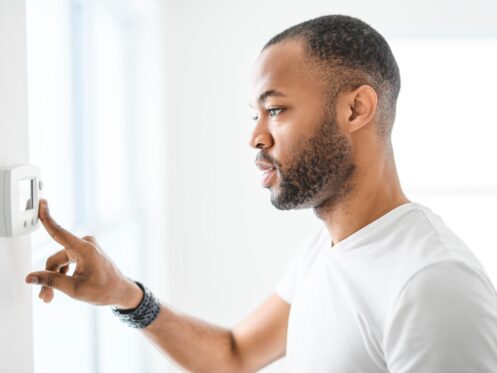A working thermostat is vital for maintaining the right temperature in your living spaces, ensuring your home remains comfortable year-round. In this article, we’ll look into the usual reasons of power issues with thermostats and explore practical solutions. We aim to guide you through troubleshooting steps and highlight when it’s best to seek professional help. Let’s get started on understanding how thermostats work and what might cause them to lose power.
Understanding How Thermostats Work
To effectively troubleshoot a thermostat that has no power, it’s essential to understand how these devices work in a heating and cooling system. Thermostats are the control centers for heating and cooling, allowing you to set and maintain your desired indoor temperature. They work by signaling the HVAC system to turn on or off based on the temperature settings.
For a deeper understanding of how home thermostats operate, you can refer to How Home Thermostats Work | HowStuffWorks. This resource provides a comprehensive look at the basic mechanics of thermostats, which can help you grasp the troubleshooting process better.
In essence, thermostats measure the room temperature and compare it to the set temperature. If there’s a discrepancy, they send a signal to the HVAC system to adjust accordingly. This regulation is crucial for maintaining energy efficiency and comfort in your home. Now that you have a foundational understanding, let’s explore some common reasons why your thermostat might lose power.
Common Reasons for Thermostat Has No Power
Understanding the common causes can help you address the issue quickly. Here are some typical reasons why your thermostat might lose power:
- Power Outages: A power outage in your area can cause your thermostat to lose power temporarily. Ensure that power is restored before troubleshooting further.
- Tripped Circuit Breakers: Sometimes, a circuit breaker may trip, cutting off power to the thermostat. Check your electrical panel to see if any breakers have tripped.
- Wiring Issues: Loose or damaged wires can interrupt the power supply to your thermostat. Inspect the wiring for any visible issues. For more details, visit 6 Possible Reasons Why Your Thermostat’s Display Isn’t Working.
- Batteries Need Replacement: If your thermostat operates on batteries, they may be drained. Replacing the batteries could resolve the issue.
Troubleshooting AC Unit No Power to Thermostat
If your thermostat is not receiving power, there are several troubleshooting steps you can take to identify and possibly resolve the problem:
- Check Circuit Breakers: Go to your home’s electrical box and look for any tripped breakers. Reset any that may have tripped to restore power to your thermostat.
- Inspect Wiring: Check the thermostat’s wire connections closely. Ensure that all wires are securely connected and not damaged. If you’re unsure, it might be best to consult a professional.
- Replace Batteries: If your thermostat uses batteries, replace them with new ones. This simple fix can often solve the problem.
- Check the HVAC System Power Switch: Make sure the power switch for your HVAC system is turned on. It is usually located near the furnace or air handler.
- Look for Blown Fuses: Some HVAC systems have fuses that may blow, cutting off power to the thermostat. Replace any blown fuses to restore functionality.
These steps can help you address basic issues with your thermostat. However, if the problem persists, it may be time to seek professional assistance. Remember, dealing with electrical components can be dangerous, and professional help ensures safety and proper handling.
AC Thermostat No Power: When to Call a Professional
While some thermostat power issues can be resolved with simple troubleshooting, there are times when expert help is needed. Here are a few scenarios where calling in the experts is the best course of action:
- Complex Wiring Problems: If you suspect that the wiring is faulty or if you’ve already checked the wiring and the issue persists, it’s crucial to contact a professional. Handling electrical components can be dangerous without the right expertise.
- Persistent Power Issues: If your thermostat continues to lose power despite troubleshooting efforts, a deeper issue may be at play. A professional can diagnose and fix the problem efficiently. Learn more about potential issues at 7 Signs Your Thermostat Is Bad.
- Safety Concerns: When dealing with electrical systems, safety should always come first. Professional technicians have the training and tools to handle these situations safely.
At Quality Cooling and Heating, we offer expert HVAC services to ensure your home remains comfortable and safe. Our team is equipped to handle any thermostat issues you may encounter, providing reliable solutions tailored to your needs. Visit our website to learn more about our services and how we can help.
Replacing Thermostat: A Solution to Power Issues
In some cases, replacing the thermostat might be the most effective solution to resolve power issues. Here’s what you need to consider:
- Compatibility: Ensure that the new thermostat is compatible with your HVAC system. This will prevent future issues and make sure it works well.
- Professional Installation: While some homeowners may feel comfortable installing a thermostat themselves, professional installation guarantees proper setup and functionality. This can also help avoid voiding any warranties.
- Advanced Features: Consider upgrading to a smart thermostat for enhanced control and energy efficiency. These devices offer features such as remote access and scheduling to optimize your home’s comfort and energy use.
Quality Cooling and Heating offers professional installation services to ensure your new thermostat is set up correctly. Our team is dedicated to providing high-quality service, ensuring your HVAC system runs smoothly. Contact us today to schedule an installation or learn more about our range of services.
Improving Energy Efficiency in Your Home
Boosting energy efficiency in your home is a smart way to save on utility bills and lower your impact on the environment. While addressing issues like a thermostat has no power, consider these energy-saving tips:
- Regular Maintenance: Keep your HVAC systems in top shape with regular check-ups. This ensures they run efficiently and last longer.
- Seal Air Leaks: Inspect doors and windows for drafts. Sealing these leaks can prevent energy loss.
- Use Programmable Thermostats: Set your thermostat to adjust the temperature automatically when you’re away or asleep, optimizing energy use.
- Upgrade Insulation: Proper insulation in your attic and walls helps maintain a consistent indoor temperature.
- Efficient Heating and Cooling: Utilize ENERGY STAR-rated products for heating and cooling to maximize efficiency. Visit ENERGY STAR for more tips on heating and cooling efficiently.
By implementing these strategies, you not only resolve immediate issues but also contribute to a more sustainable home environment.
Ensuring Comfort with Quality Cooling and Heating Services
In conclusion, keeping a properly working heating and cooling system is crucial for comfort and energy efficiency. Whether you’re dealing with a thermostat has no power or looking to enhance your home’s energy efficiency, Quality Cooling and Heating is here to help. Our professional team offers a range of services tailored to meet your needs, from repairs and maintenance to complete installations.
- Reliable Solutions: We provide dependable HVAC services, ensuring your home remains comfortable year-round.
- Community-Focused: Our commitment to the Greater Austin and Abilene areas means we prioritize customer satisfaction and community well-being. Learn more about our services in the area at Leander AC Services.
- Expertise You Can Trust: With our experienced professionals, you can have peace of mind knowing your HVAC system is in good hands.
For more information or to schedule a service, visit our website. Let us help you create a comfortable and efficient home environment.


